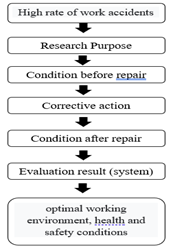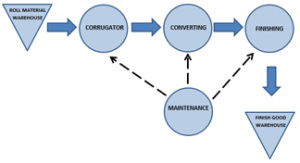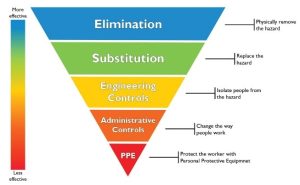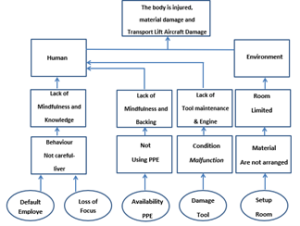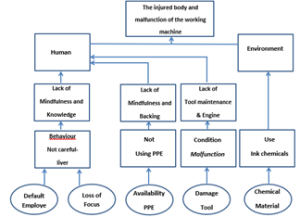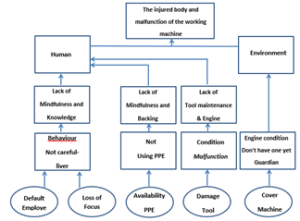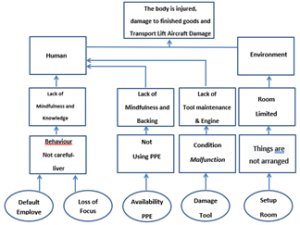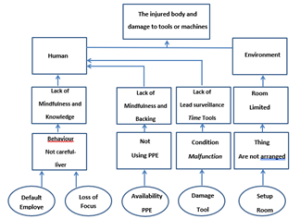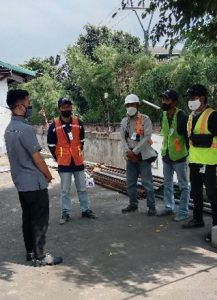Analysis of the Work Environment and Occupational Health, Safety (K3) in the Carton Box Packaging Industry Using the Fault Tree Analysis (FTA) Method (Case Study of Pt. Carton Box Manufacturing Bekasi Regency)
- Ali Hanafi
- Dikka Safriyanto
- Ghenni Puja Whardana
- Rizqi Adji Ramdani
- Yudi Prastyo
- 605-620
- Jul 22, 2024
- Health
Analysis of the Work Environment and Occupational Health, Safety (K3) in the Carton Box Packaging Industry Using the Fault Tree Analysis (FTA) Method (Case Study of Pt. Carton Box Manufacturing Bekasi Regency)
Ali Hanafi, Dikka Safriyanto, Ghenni Puja Whardana, Rizqi Adji Ramdani, Yudi Prastyo
Industrial Engineering Study Program, Faculty of Engineering, Pelita Bangsa University
Jl. Inspection Kali Malang No. 9 Cibatu Village, South Cikarang District, Bekasi Regency, West Java (17530)
DOI: https://doi.org/10.51244/IJRSI.2024.1106046
Received: 28 May 2024; Revised: 15 June 2024; Accepted: 21 June 2024; Published: 22 July 2024
ABSTRACT
The cardboard box packaging industry is a form of innovation in paper-based packaging products which includes outer protective packaging for food, automotive and other finished products, PT. Cikarang Cardboard Box Manufacturing is a multi-national company that operates in the field of manufacturing paper-based packaging sourced from paper recycling processing, so that in its operations it still pays attention to environmental aspects for the continuation of the next generation. As a provider of large-scale cardboard packaging, the company certainly has business ethics and occupational health and safety (K3) regulations that must be adhered to by all employees and guests who visit it, however there are still cases of work accidents that occur every year, the measurement of the level of work accident cases is based on data obtained based on direct observation, Therefore, work health and safety (K3) analysis research was carried out using the Fault Tree Analysis (FTA) method. From the analysis carried out by researchers, it was found that the cause of work accidents that occurred was due to employee understanding, bad habits that occurred (unsafe action). and the work environment is in an unsafe condition. So the solution to this problem is that it is hoped that the company can tighten K3 regulations in the company environment in order to improve company performance and reduce the number of work accidents that occur in the company environment.
Keywords: Health, Work Safety (K3), Work Accident and Faulth Three Analysis (FTA).
INTRODUCTION
The manufacturing industry is an industrial sector that plays an important role in the progress of the wheels of economic turnover in Indonesia, from the economic side the manufacturing industry is the process of converting raw materials into a product that has added value through the stages of the process and assembly in it, in practice the operational activities of the manufacturing industry have various potentials that can be explored in it, the potential can be in the form of positive benefits and potential dangers negatively, Great potential needs to be balanced with wise and wise progress so that it can be maximized efficiently.
It can be found that the role of occupational health, safety (K3) is often ignored for various reasons behind it, ranging from reasons that hamper company operations, assume that K3 does not affect company profits, consider that K3 wastes costs and causes capital overruns and does not have time to take care of K3. However, the role of K3 in the company environment is no less important than the role of operational activities in the company, because K3 is a form of effort to care about the company’s own survival, with the implementation of K3, the company contributes to the welfare of workers, complies with applicable legal regulations and is a long-term investment for the company.
Cikarang Carton Box Manufacturing is a multinational company engaged in the manufacture of packaging made from cardboard, most consumers are food and beverage companies and automotive companies in the Java and Sumatra Island regions, the company has been established since 2006 and has 352 employees who work every day, as a company engaged in the packaging industry, PT. Carton Box Packaging Manufacturing has business ethics and K3 rules that must be obeyed, the company has also tried to be able to implement K3 but there are still cases of work accidents that occur every year. Therefore, an analysis is needed related to the application of K3 in the company environment which can be a reference for the application of K3 in the company environment in order to improve employee performance and productivity and reduce the number of work accident cases in the company environment.
Based on these considerations, this research was carried out by attempting to analyze the level of work accidents and the causes of work accidents using the Fault Tree Analysis (FTA) method which can identify the causes of errors in a process.
STUDENT LITERATURE
2.1 Work Environment
The work environment is a place for workers or employees to carry out work activities every day, a good work environment produces a positive impact on workers or employees by contributing to supporting employees in a healthy, safe and comfortable state both physically and psychologically impacting workers and can have a major impact on company profits, therefore a good work environment is needed both by the company and by worker.
According to Pandi Afandi (2016: 51) the work environment is something that exists in the environment of workers that can affect them in carrying out tasks such as temperature, humidity, ventilation, lighting, noise, workplace cleanliness and whether or not work equipment is adequate.
Some indicators of the work environment include working atmosphere, relationships with colleagues, lighting, air circulation, noise, unpleasant odors and safety. A good work environment includes comfort, safety and adequate hygiene for workers, to create a good work environment requires contributions from the company as a workplace provider, managers responsible for facilities and the environment and workers as people who work in the work area.
2.2 Occupational Health, Safety (K3)
According to the World Health Organization (WHO) Understanding K3 is an effort that aims to improve and maintain the highest degree of physical, mental and social health for workers in all types of work, prevention of worker health problems caused by working conditions, protection for workers in their work from risks due to adverse factors for the company.
Based on the regulations stated in Law No. 1 of 1970 concerning occupational safety, it is stated that: work safety which among others contains terms, scope, work safety requirements, supervision, coaching, work safety and occupational health guidance committee; accident; labor obligations and rights; obligations when entering the workplace; and the obligations of the board.
2.3 K3 Culture
K3 culture is a form of behavior, attitudes and values together in order to achieve a healthy and safe degree of performance, which is understood and made a top priority in an organization. K3 culture is created from the existence of regulations and norms that bind employers and workers to be able to carry out safe and healthy business activities.
According to the Safety Advisory Group (1991) K3 culture is a combination of character and behavior in the organization and individuals who are formed into top priorities, which become safety issues that receive important attention to facilities.
The rooting of K3 culture needs to be done from the highest to the lowest level, so that K3 culture can be understood and carried out consistently because K3 culture can provide a sense of security and comfort and have many positive impacts on workers and companies, K3 culture also needs to be used as a fundamental basis that is instilled as a positive doctrine for every worker before and after carrying out work, as stated in the mandate of the 1945 Constitution that every Indonesian has the right to a decent living and work.
2.4 Risk Management
According to Herman Darmawi (2006) stated, risk management is an effort to know, analyze, and control risks in every company activity, with the aim of obtaining higher effectiveness and efficiency.
It can be interpreted that, risk management is a structured approach or methodology in managing uncertainty related to threats; A series of human activities include: risk assessment, development of strategies to manage them and risk mitigation using empowerment or resource management.
Risk management aims to provide risk information for the organization so that the organization can make efforts so that the risk does not occur or reduce the impact caused by it. Risk management includes the application of policies, procedures and practices to implement the application of context, risk identification, risk analysis, risk evaluation, risk handling, monitoring and review, communication and consultation.
RESEARCH METHODS
The research method used in this study tends to be qualitative research methods, where qualitative research methods emphasize deeper aspects of observation, derived from interviews conducted with experienced sources and are located or directly involved in the work area and data recorded based on events that occur in the company environment.
While the method carried out in this study is the Fault Tree Analysis (FTA) method, the FTA method is an analytical method that can find aspects of the system involved in the main failure and find the cause of product defects in the production process, the FTA method developed in 1995 which is commonly used by the US air force and carried out by Bell Laboratories which is used on the grounds of high cases of aviation accidents.
In general, the FTA method is used by mechanical engineers, especially in industries where the technical failure rate has a major impact on the aviation nuclear industry.
The basic form of the FTA method refers to the shape of the tree where at the top there is a result of the reaction contained below, the bottom of the tree has roots or sources of problems that affect the treetops in the FTA method.
To find out the stages of research, can be seen in figure 1.
Figure 1 Stages of research
The next stage of research is to carry out Focus Group Discussion (FGD) which is carried out by involving internal operational teams with external teams who have K3 backgrounds in the field to determine the main causes of high cases of work accidents.
In the next stage, the researcher explained the plan to improve the occupational health, safety (K3) system in the company by considering the aspects that cause the high cases of work accidents so as to produce a more optimal system and suggestions that can be used by the company.
RESULTS AND DISCUSSION
This research focuses on the problems faced by the company, namely the high number of work accident cases, namely 9 cases that occurred in operational areas and occurred in the period 2023 involving workers including technicians and production operators, causing losses and affecting the level of effectiveness, productivity and time efficiency. in the production area. Based on the results of the analysis, it is known that the causes are due to employee understanding, bad habits that occur (unsafe actions) and the work environment being in an unsafe condition.
Early Identification
Karton Box Cikarang is a company engaged in the production of paper-based packaging, in practice operational activities in the company have a lot of potential in it, among various potentials there are potential hazards around the work area, work accidents occur in the company area caused by various factors behind, including internal factors and external factors of the company.
Internal factors are influenced by the work environment and work area conditions within the company, while external factors are influenced by workers’ lifestyles, weather and conditions that occur outside the company area. Among the information that occurred above, data on cases of work accidents that occurred in the company are outlined in table 1.
Table 1: Work Accident Data for 2023
| No | Moon | Sum | Work Area |
| 1 | January | 1 Case | Maintenance |
| 2 | February | 1 Case | Finishing |
| 3 | March | 1 Case | Finishing |
| 4 | May | 1 Case | Corrugator |
| 5 | July | 2 Cases | Converting |
| 6 | Agust | 1 Case | Finishing |
| 7 | October | 2 Cases | Corrugator, Converting |
Based on the data presented above, it can be seen that there are 9 cases of work accidents that occur in the company environment, in general, work accident cases occur due to negligence committed by workers, based on these conditions this study aims to find the root of the problem that occurs and determine solutions and suggestions that can be used by the company as a corrective step.
The initial step in this study is to collect data based on case histories that occur in the company environment, researchers also make direct observations in the field by involving company representatives and external representatives who have expertise in the field of K3 and become the focus of research to find out the root cause of the high cases of work accidents using Focus Group Discusion (FGD) in the company environment.
FGD participants consisted of 3 internal company people who are experienced in the field of human resources, production machinery and Production Planning and Inventory Control (PPIC), external representatives consisted of 2 people who were experienced and had K3 certification and experienced in the field of layout that contributed to analyzing the causes of high cases of work accidents that occurred in the company.
Table 2: Focus Group Discussion (FGD) Team
| Age (Years) | Work Experience (Years) | Department | Special Skills | Information | |
| FGD1 | 44 | 22 | Manager HRD&GA | Psychology and HR | Internal |
| FGD2 | 43 | 21 | Manager PPIC | Sypply Chain & Time Management | Internal |
| FGD3 | 44 | 24 | Manager Engineering | Technical Engineering | Internal |
| FGD4 | 35 | 13 | General K3 Expert | K3L | External |
| FGD5 | 23 | 5 | General Affair Leader | Ergonomics &; Layout | External |
Figure 2 Production Process Flow
In the FGD discussion agenda, it is known the flow of the production process described in figure 2, based on the flow of the production process, there are 6 major parts which include the storage of raw materials in the roll material storage warehouse, corrugator production process, converting production process, finishing production process, control process and improvement of machine conditions in the maintenance department and the finished goods storage process before finally being sent to the customer. In its implementation, there are potential hazards and employee behaviors discussed in the FGD above, among the hazard behaviors contained in the process are as follows:
- Non-compliance of clamplift operators, checkers and incoming Quality Control (QC) operators in using PPE and maintaining a safe distance on clamplift lift vehicles that are operating in the process of receiving roll material, checking rolls and tidying rolls into layouts.
- Non-compliance of corrugator machine operators in using PPE in the work area.
- Corrugator machine operators often work in a state of fatigue and unfocus so that they lose concentration in the work process.
- Non-compliance of converting machine operators in using PPE in the work area.
- Converting machine operators often work in a state of fatigue and unfocus so that they lose concentration in the work process.
- Non-compliance of machine operators in the finishing area in using PPE in the work area.
- Machine operators in the finishing area often work in a state of fatigue and unfocus so that they lose concentration in the work process.
- Non-compliance of forklift operators, checkers and outgoing Quality Control (QC) operators in using PPE and maintaining a safe distance on forklift lift vehicles that are operating in the process of loading finished goods.
- The condition of the area and the machine used is in poor condition or technical faults that cause the failure of production machine fusion.
In K3 known hazard control hierarchy as outlined in figure 3 below:
Figure 3 Hazard Control Hierarchy
According to the National Institute for Occupational Safety & Health (NIOSH), the hazard control hierarchy is a way to determine the best course of action in controlling the source of the hazard. In the existing hazard control hierarchy, there are 5 segments that are grouped based on the effectiveness of the impact of application that occurs when applying the principle of the hazard control hierarchy. In the first hierarchy, there is elimination which means elimination, what is meant by elimination is the complete elimination of the source of danger contained in the work area or situation in the work area. The use of elimination in hazard control is considered the most effective because elimination eliminates the entire source of the hazard that occurs.
The second hierarchy is substitution, meaning replacement which means replacing part or all of the existing sources of danger by using better tools or places, the substitution hierarchy is considered quite effective because it replaces the tools or places that are sources of danger with better ones. The third hierarchy is technological engineering, which means changing and modifying the source of danger using existing technology so that the source of danger can be controlled, technological engineering is considered effective and, in the middle, because the existing source of danger is not eliminated and replaced but only modified so that the level of danger can be controlled.
The fourth hazard control hierarchy is administrative control, meaning the administrative application of hazard prevention and control from the administrative side which aims to provide an overview, documentation, education and data collection facilities in the K3 field, the application of administrative control in the K3 field can be in the form of making Hazard Identification, Checklist of control and control of protective and personal protective equipment, documentation systems and educational facilities. Administrative control is in fourth place which means it is not very effective in controlling hazards in the work environment.
The last hazard control hierarchy is PPE which means personal protective equipment, PPE is the last step taken in hazard control, the level of effectiveness of PPE use is considered the least effective, because the use of PPE only protects part or all of the body of workers who use PPE without eliminating the level of danger that occurs in the work environment in the area.
Finding the Cause of Work Accidents Using the Faulth Tree Analysis (FTA) Method
In analyzing cases of work accidents that occur in the work area, it can be seen by knowing what the cause of work accidents is, using the Fault Tree Analysis (FTA) method, it can be known what causes work accidents that occur in the work area. The following is the description of the FTA method applied in PT. Carton Box Manufacturing Cikarang are:
- Material Roll Warehouse Area
Based on existing work accident data, throughout 2023 there will be no work accidents in the roll material storage warehouse area, but the area has potential hazards in it, because in practice it uses clamplift type lift aircraft and the weight of raw materials that have an average weight of 3 tons / pcs. The hazard source factors include:
Table 3: Causes of Work Accidents in the Material Roll Warehouse
| Type of Job/Activity | Aftermath of an accident | Cause |
| Unloading Material Roll, Supply Roll and tidying up material roll to warehouse | Body injuries, material damage and damage to lift aircraft | Default employee |
| Lack of focus | ||
| Not wearing PPE | ||
| Tool malfunction | ||
| Lack of room arrangement |
It can be seen in table 3, the types of work activities in the material roll warehouse area that have potential hazards and due to accidents based on 5 causes that are the root cause of work accidents that can occur in the material roll storage warehouse area. In this case, to find the cause of work accidents, researchers use the
FTA method in the work area of the maerial roll warehouse which is described in the following figure:
Figure 4 Model Fault Tree Analysis Material Roll Warehouse
Based on the results of the analysis conducted using the FTA method, it can be known that the root cause of work accidents in the material roll warehouse area is on the human side, where there is behavior from workers caused by lack of knowledge, awareness and care carried out that causes potential danger.
While on the environmental side, there is a limited work area so that the arrangement of the room becomes not optimal and causes the area to be unorganized and there is the potential for unsafe conditions that are dangerous for workers, equipment and materials.
- Corrugator Production Area
From the data collected throughout 2023, there have been 2 cases of work accidents in the corrugator production area and the area has potential hazards in it, because in practice operators operate machines that have a large size and rely on hot steam power and electricity as engine driving force. The factors of the source of danger include:
Table 4: Causes of Work Accidents in Corrugator Production Areas
| Type of Job/Activity | Aftermath of an accident | Cause |
| Operating corrugator production machines | Injured body and malfunction of working machines | Default employee |
| Lack of focus | ||
| Not wearing PPE | ||
| Tool malfunction | ||
| Hot and noisy working environment |
It can be seen in table 4, types of work activities in corrugator production areas that have potential hazards and due to accidents based on 5 causes that are the root cause of work accidents and occupational diseases that can occur in corrugator production areas. In this case, in order to find the cause of work accidents, researchers use the FTA method in the corrugator production work area which is described in the following figure:
Figure 5 Fault Tree Analysis Model of Corrugator Production Area
From the results of the analysis conducted using the FTA method, it can be known that the root cause of work accidents in the corrugator production area is on the human side, where there is behavior from workers caused by lack of knowledge, awareness and care carried out that causes potential danger.
While on the environmental side, there is a hot and noisy work area that can cause the risk of work accidents and occupational diseases and there is the potential for unsafe conditions that are dangerous for workers, equipment and materials if they do not carry out careful work activities, repair and modification of the work environment and the use of PPE that is obeyed by all workers.
- Converting Production Area
Based on data collected throughout 2023, there have been 2 cases of work accidents in the converting production area and the area has potential hazards in it, because in practice the operator operates a machine that has a large size and there are ink chemicals used as image printing media on cardboard. The factors of the source of danger include:
Table 5: Causes of Work Accidents in Converting Production Areas
| Type of Job/Activity | Aftermath of an accident | Cause |
| Operating converting production machines | Injured body and malfunction of working machines | Default employee |
| Lack of focus | ||
| Not wearing PPE | ||
| Tool malfunction | ||
| Use of ink chemicals |
It can be seen in table 5, the types of work activities in the converting production area that have potential hazards and the consequences of accidents are based on 5 causes that are the root cause of work accidents and occupational diseases that can occur in the converting production area. In this case to find the cause of work accidents, researchers use the FTA method in the converting production work area which is described in the following figure:
Figure 6 Model Fault Tree Analysis Production Area Converting
Based on the results of the analysis conducted using the FTA method, it can be known that the root cause of work accidents in the converting production area is on the human side, where there is behavior from workers caused by lack of knowledge, awareness and care carried out that causes potential danger.
While on the environmental side, there are work machines that use ink chemicals as coloring materials to print images on cardboard so that it can cause the risk of work accidents and occupational diseases, namely exposure to ink on the body and mucous membranes such as eyelids and mouth, the use of PPE is absolutely mandatory for all workers.
- Finishing Production Area
Based on data collected during 2023, there are 3 cases of work accidents in the finishing production area that have been successfully recorded and become the department with the most work accident cases throughout 2023, these areas have potential hazards in them, because in practice operators operate machines that have large sizes. The factors of the source of danger include:
Table 6: Causes of Work Accidents in the Finishing Production Area
| Type of Job/Activity | Aftermath of an accident | Cause |
| Operating Finishing production machines | Injured body and malfunction of working machines | Default employee |
| Less focus | ||
| Not wearing PPE | ||
| Tool malfunction | ||
| Some parts of the engine do not yet have a protective cover |
It can be seen in table 6, types of work activities in the converting production area that have potential hazards and the consequences of accidents based on 5 causes that are the root cause of work accidents that can occur in the finishing production area. In this case to find the cause of work accidents, researchers use the FTA method in the fishing production work area which is described in the following figure:
Figure 7 Model Fault Tree Analysis Production Area Finishing
Based on the results of the analysis conducted using the FTA method, it can be known that the root cause of work accidents in the finishing production area is on the human side, where there is behavior from workers caused by lack of knowledge, awareness and care carried out that causes potential dangers.
While on the environmental side, there are work machines that do not have a protective cover so that they can cause the risk of work accidents, the use of PPE is absolutely mandatory for all workers.
- Finished Goods Warehouse Area
Based on existing work accident data, throughout 2023 there will be no work accidents in the finished goods warehouse area, but the area has potential hazards in it, because in practice it uses forklift type lift aircraft and the weight of raw materials that have an average weight of 300 Kg / Pallet. The factors of the source of danger include:
Table 7: Causes of Work Accidents in Finished Goods Warehouses
| Type of Job/Activity | Aftermath of an accident | Cause |
| Loading finished goods into truck fleets, storing finished goods and tidying up warehouse areas | Body injuries, finished goods damage and transport lift aircraft damage | Default employee |
| Lack of focus | ||
| Not wearing PPE | ||
| Tool malfunction | ||
| Lack of room arrangement |
It can be seen in table 7, types of work activities in the finished goods warehouse area that have potential hazards and the consequences of accidents based on 5 causes that are the root cause of work accidents that can occur in the finished goods storage warehouse area. In this case to find the cause of work accidents, researchers use the FTA method in the work area of the finished goods warehouse which is described in the following figure:
Figure 8 Model Fault Tree Analysis Area of Finished Goods Warehouse
Based on the results of the analysis conducted using the FTA method, it can be known that the root cause of work accidents in the finished goods warehouse area is on the human side, where there is behavior from workers caused by lack of knowledge, awareness and care carried out that causes potential danger.
While on the environmental side, there is a limited work area so that the arrangement of the room becomes not optimal and causes the area to be unorganized and there is the potential for unsafe conditions that are dangerous for workers, equipment and materials.
- Maintenance Area
Based on existing work accident data, throughout 2023 there will be 1 case of work accidents in the maintenance area, the area has potential hazards in it, because in practice workers repair machines or vehicles using mechanical tools that have risks in their application, such as lathes, grinders and welding, this work is also inseparable from heat and electrical hazards. The factors of the source of danger include:
Table 8: Causes of Work Accidents in the Maintenance Area
| Type of Job: /Activity | Aftermath of an accident | Cause |
| Repair of engines, vehicles and utilities | Injured body and damage to tools or machinery | Default employee |
| Lack of focus | ||
| Not wearing PPE | ||
| Tool malfunction | ||
| Lack of room arrangement |
It can be seen in table 8, types of work activities in the maintenance area that have potential hazards and due to accidents based on 5 causes that are the root cause of work accidents that can occur in the maintenance area. In this case to find the cause of work accidents, researchers use the FTA method in the maintenance work area which is described in the following figure:
Figure 9 Model Fault Tree Analysis Maintenance Area
Based on the results of the analysis conducted using the FTA method, it can be known that the root cause of work accidents in the Maintenance area is on the human side, where there is behavior from workers caused by lack of knowledge, awareness and age control of work tools or machines carried out causing potential hazards.
While on the environmental side, there is a limited work area so that the arrangement of workshop and workshop rooms is not optimal and causes the area to be unorganized and there is the potential for unsafe conditions that are dangerous for workers and equipment.
Prevention of Work Accidents
Prevention of work accidents begins by paying attention to aspects of the existing hazard control hierarchy, applying K3 principles and rules and fostering interest, curiosity, knowledge and culture of K3 in the work environment. K3 patrol activities, the application of educational facilities, administration and the use of PPE are also things that need to be done.
The PPE to be selected must be in accordance with standards such as: ANSI, OSHA, NFPA, UL, NIOSH, and SNI applicable in Indonesia. The use of PPE must be adjusted to the workplace environment and the potential hazards contained in it, so the risk of the work environment must be reassessed periodically to see the changes that occur. In this case, regular meetings of the hazard control committee and K3 need to be intensified at least once every 1 month, as a step to evaluate the performance of K3 in the company environment. PPE used every day will certainly experience changes in physical form, therefore authorized officers in the company are encouraged to conduct weekly inspections to check the feasibility of PPE and will be followed up with supervisors / area managers. All levels of positions have the same obligation and awareness to be able to remind and pay attention to the feasibility of PPE used in order to minimize the risk of work accidents.
The company’s commitment in controlling hazards and complying with K3 rules is shown by implementing the following:
- Preparation of K3 work plan
The work plan is outlined in the HSE work program which is carried out every day, the work plan is made based on the Standard Operational Procedure (SOP) for emergency response to hazards contained in the company, with the regulation the company has administrative evidence which is one of the applications of the hazard control hierarchy, evaluation efforts are carried out periodically and monitored directly by management.
- Implementation of K3 work plan
The K3 work plan that has been analyzed, made and approved by each authority must be implemented and implemented consistently by all employees with close operational supervision by the company’s leadership level, in this case the work plan pays attention to the application of responsible authorities, hazard risk assessment, preparation of work sites in accordance with the place of work assignment, provision of adequate equipment, vehicles and facilities, routine maintenance and inspection, review and evaluation, solid, liquid, B3 and domestic waste management, traffic management and fire hazard control.
- Learning Development
In controlling hazards and implementing K3, it is necessary to conduct training, providing information, socialization and providing understanding to all employees, guests and workers who will carry out activities in the company environment, this is intended so that employees can understand the basics of K3, implement it in work activities and be able to avoid potential hazards that occur, engineers can understand the danger conditions around them and can respond quickly when conditions occur Hazards in the work area that can befall him, his colleagues and assets belonging to the company.
Safety talk at the beginning of the activity also needs to be done to create awareness and to be a means of reminding employees about the importance of K3 and avoiding hazards in the work environment. Safety talk can be in the form of a simple briefing at the beginning of work, where superiors / leaders in each department and section can act as speakers in the short briefing. The following is an overview of safety talk at the beginning of the project led by the company that has the authority and responsibility for K3 to ensure worker safety, environmental safety and completeness of equipment and materials.
Figure 10 Safety Talk at the Start of the Project
- K3 Inspection and Audit
From the program plan that has been made, K3 inspections and audits are recommended to be applied as a systematic approach to review the application of K3 in the work area. Audits can be carried out by internal and external parties periodically quarterly or one semester to create an evaluation of the performance of the K3 team and an evaluation of the implementation of K3 in the company environment.
- Give Reward and Punishment
As an effort to enforce and give appreciation to workers for efforts to implement K3 culture in the company environment, management needs to reward workers or parts who consistently become pioneers of implementing K3 in the work environment, this is intended as a form of company attention to every worker who works in the company.
Punishment can also be applied as a form of disciplining workers for violating or non-complying with the K3 rules set by the company, this is intended as the company’s effort to pay attention to and enforce K3 rules within the company.
CONCLUSION
Based on the research that has been done, it can be concluded that K3 planning has been created and implemented in the company, however evaluation steps need to be carried out in order to improve and improve towards a better direction, efforts to reduce the number of work accidents are also continuously carried out by the company. The use of the FTA method is intended to analyze and be able to search for aspects of the system that are involved in the main failure and find the causes of product failure in the production process.
By using FTA, companies are able to find out the causes of work accidents that occur within the company. The factors causing work accidents using the FTA method are:
- Employees do not wear PPE.
- Employees lose focus while working due to fatigue.
- Employees are negligent at work.
- Lack of warehouse space arrangement.
- Not concentrate.
- As well as low knowledge and understanding of K3.
The application of the K3 hierarchy which is emphasized to company management also has a big influence on controlling existing hazards, such as eliminating sources of danger, replacing them with safer ones, modifying equipment, machines and work areas to make them safer, implementing K3 administration and emphasizing the use of PPE in work areas.
Implementing rewards and punishments also needs to be done as an effort to enforce K3 rules and give rewards to employees. Instilling an K3 culture can also be done by implementing a learning and development system for employees as an effort to provide education and understanding to employees and remind employees through safety talks at the start of work.
Based on these results, it is hoped that companies can tighten K3 regulations in the company environment in order to remind the company’s performance and reduce the number of work accidents that occur in the company environment by implementing the K3 hierarchy and hazard control and being able to act decisively without regard to all employees and at all levels.
BIBLIOGRAPHY
- A.Made Alit Putra, d. (2022). THE EFFECT OF WORK STRESS, PHYSICAL WORK ENVIRONMENT, OCCUPATIONAL SAFETY AND HEALTH ON EMPLOYEE JOB SATISFACTION ON CV. BALI IMAGE COLLECTION IN BATUBULAN, GIANYAR.
- Abdul Azis Syarif, d. (2023). ANALYSIS OF OCCUPATIONAL HEALTH AND SAFETY SYSTEMS AT PT SUMBER SAWIT MAKMUR USING HAZARD IDENTIFICATION RISK ASSESSMENT AND RISK CONTROL (HIRARC) AND FAULT TREE ANALYSIS (FTA) METHODS. Journal of Al Ulum LPPM Al Washliyah University Medan .
- Ade Rahmawati, d. (2020). THE INFLUENCE OF THE PERCEPTION OF THE PHYSICAL WORK ENVIRONMENT ON OCCUPATIONAL SAFETY HEALTH (K3) FIELD EMPLOYEES OF PT. ANTANG MOUNT MERATUS. Journal of Kognisia.
- Jean R. Asthenu, V. R. (2022). The effect of occupational safety and health and the work environment on employee work productivity. JOURNAL OF MANEKSI VOL 11, NO. 2.
- Mona, I. S. (2022). The influence of motivation, environment, and work safety on employee performance. Journal of Management.
- Ryani Dhyan Parashakti, P. (2020). THE EFFECT OF OCCUPATIONAL SAFETY AND HEALTH (K3), WORK ENVIRONMENT AND WORKLOAD ON EMPLOYEE PERFORMANCE. JIMT.
- Vani Kenanga Nan Wangi, d. (2020). The impact of occupational health and safety, workload, and physical work environment on employee performance. Journal of Business Management.
- Suparwo Adi, et al. 2019. “Occupational Safety and Health Management in Bandung Indo Garment UMKM”. Journal of Community Service. Vol. 2, no. 1
- Risk Assessment – In General – Indonesia Risk Management Professional Association. (n.d.). Retrieved May 27, 2021, from https://irmapa.org/peringan-risiko-in-general
- Vaskiano W, Dolongpaha G, Kawatu PAT, Wowor RE, Health F, University M, et al. Overview of the Implementation of the Occupational Health and Safety Program Hospital (K3rs) at Talaud Regional General Hospital.. Pen. 2019;8(7):18–26.
- Ningsih W, Ferijani A. Description of Occupational Health and Safety Implementation (K3) At Panca Jaya Company. Jemap. 2019;2(2):267–86.
- Alfidyani KS, Lestantyo D, Wahyuni I. Relationship between K3 Training, Use PPE, Installation of Safety Signs and Implementation of SOPs when Risks Occur Work Accidents (Study in the Semarang City Garment Industry). J Public Health e-Journal. 2020;8(4):478–84.
- Ayu S, Jayadipraja EA, Harun AA. The Relationship between the Implementation of Standard Operating Procedures and Training and the Occurrence of Work Accidents among Employees in PT. PLN Kendari City Customer Service Implementation Unit. J Public Health. 2019;9(2):170–7.
- Salmawati L, Rasul M, Napirah MR. Factors related to the event work accidents among nurses in the emergency room at Anutapura General Hospital, Palu City. J Health Masy. 2019;10(2):104–12.
- Alfiansah Y, Kurniawan B, Ekawati. Analysis of Internal K3 Management Efforts Prevention and Control. J Public Health. 2020;8(September).

